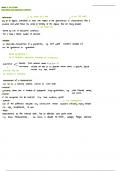Summary
Summary Mathematical Statistics 214
- Course
- Institution
Digitally summarised notes for Mathematical Statistics 214 at Stellenbosch University for the A1: includes descriptive and exploratory statistics, chapter 3/4, chapter 5 and chapter 6, chapter 7, chapter 8 and chapter 10. These notes are very properly summarised, including all examples done in c...
[Show more]



